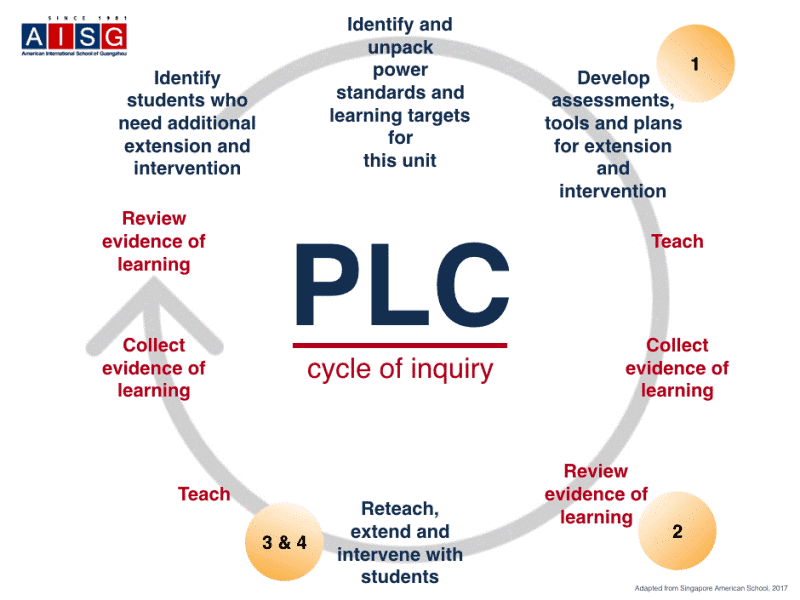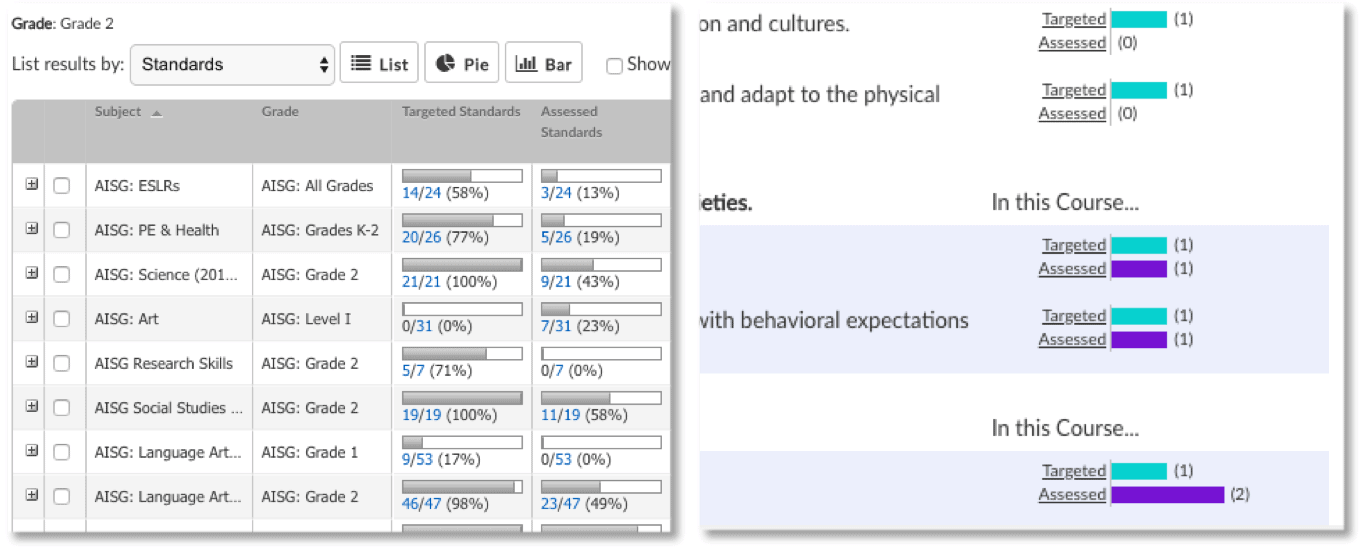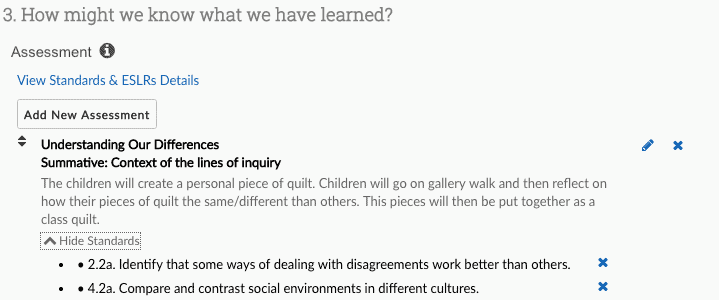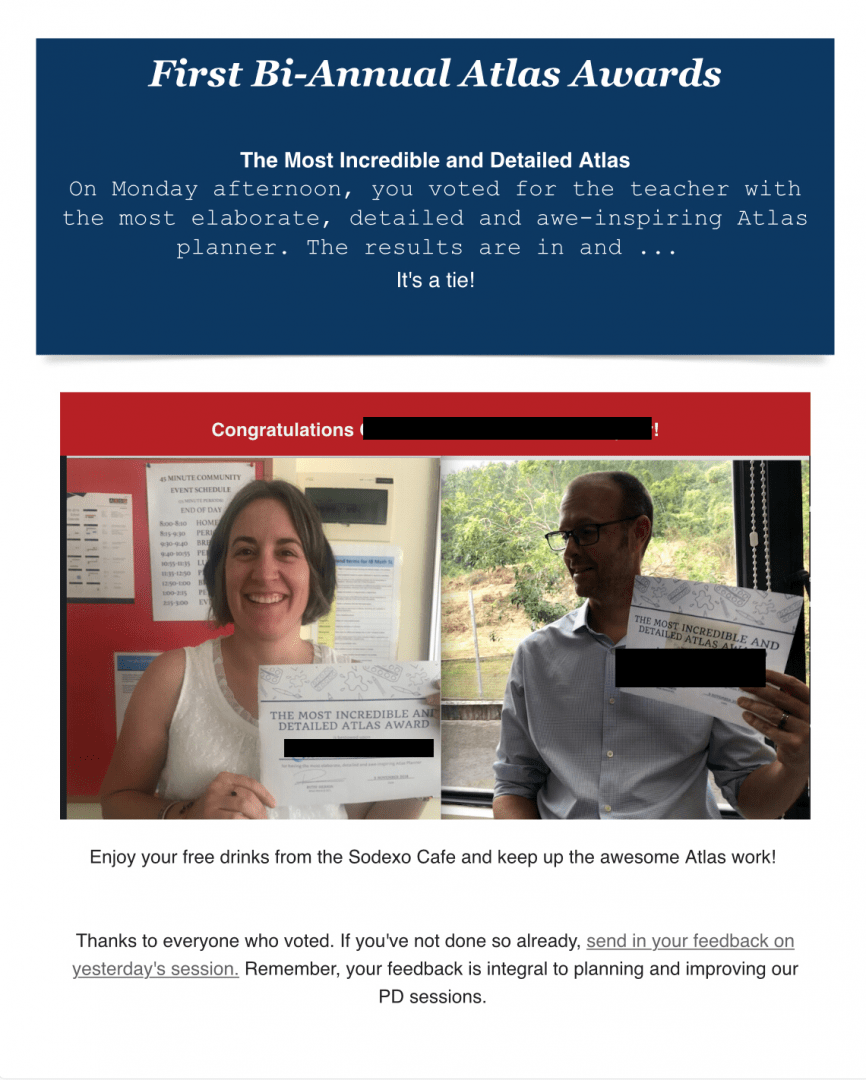By Ruth Herrin and Jeffrey Edwards American International School of Guangzhou
In any school, you are bound to see a variety of paradigms and initiatives floating about, often in the form of acronyms and edu-jargon. New faculty in schools can be overwhelmed not only by the different courses, cultures and communities they need to work with, but also by the different and numerous structures of thought.
While these paradigms might change from school to school, one thing is almost always agreed upon: we must map our curriculum and we must intentionally work to ensure that students meet the standards we have set out to accomplish. Curriculum mapping ensures a guaranteed and viable curriculum. It is our promise and our contract to the parents, students, our colleagues and our community of where we are going and what we are doing.
At the American International School of Guangzhou, we’ve worked to ensure a viable and guaranteed curriculum by mapping to Atlas and work to meet the needs of all learners through the 4 questions of professional learning communities (PLC):
- What do we want students to know? (Standards)
- How will we know when they’ve got there? (Assessments)
- What will we do if they don’t know it? (Interventions)
- What will we do if they do know it? (Extensions)
One of the primary foci our school has for the coming years is to foster increased vertical alignment amongst all divisions and learning opportunities in our school. This is especially important due to the physical distance between divisions as well as the different programs we run - while the whole school is aligned to adapted US standards for each subject area, we also have the PYP and the DP.
Atlas aids us in ensuring alignment of our curriculum, but we also need to ensure that the work we do in our PLCs is aligned in order to best meet the needs of each learner.Vertically aligned curricular planners
In an effort to ensure that not only our curriculum, but also our PLC structures were vertically aligned, we set about to marry the paradigms already at play in our school with those of the PLC four questions, Kath Murdoch’s cycle of inquiry, the PYP and DP curricula as well as a system of Pre-Kindergarten through Grade 12 standards for all subject areas.

Using the Cycle of Inquiry, we cyclically inquire about our work as professionals and in our day-to-day interactions with students all while connecting back to the 4 PLC questions.
This structure is also mirrored in the redesign of our Atlas planners where we have made explicit the connections to each PLC question in our mapping. What follows is a brief introduction to some of the ways these redesigned planners have aided teachers and coordinators at the primary and secondary levels at our school.PLC and the PYP
With the roll-out of the enhanced PYP in recent months, there has been an increased push in PYP classrooms to put student agency and opportunities for student-led inquiry right at the heart of the PYP curriculum. One common concern for PYP teachers is how we can balance open inquiry and the rigors of standards-based curriculum and the PLC framework.
Here are a few ways we’ve found the marriage of Atlas and the PLC framework has helped our team develop rigorous, inquiry-driven units:
- Utilizing standards to refocus concept-based units of inquiry
- Standards Analysis to ensure a horizontally-articulated curriculum
- PLC Question 2 (Assessment)
Standards and concept-based units of inquiry
Of the four main PLC guiding questions, Question 1 (Standards) seems the most straightforward, especially for teachers with PYP experience. The central idea, key-concepts, and lines of inquiry are all easy answers to this beginning PLC question.
One issue with this line of thinking, though, is that it can lead to stagnant units that do not develop over time as teachers possibly lose the ‘big picture’ of where the central idea came from and why it’s important.
This is where having easy access to targeted standards for each unit has been so helpful for our team.

When a unit becomes difficult to map out, we’ve found we’re constantly referring back to our original standards, then working our way up the conceptual ladder to make sure we still know the answer to that crucial first question “What do we expect our students to learn?”
Atlas standards analysis and horizontal articulation
Another common issue for inquiry-driven curricula is the difficulty for horizontal articulation. When students are often following their own paths on teacher-guided inquiry, how can curriculum directors ensure consistency across the grade level?
One way our curriculum director has managed this difficulty is through Atlas’s standards analysis tool.

Having easy access to this information allows teachers to get a much better idea where there are gaps in the curriculum and where we might be spending too much time.
How might we know what we have learned?

Once we’ve answered that first PLC question “What do we want students to know?”, answering the question “How will we know?” becomes much easier and, again, the assessment section of Atlas comes in handy here.
Referring back to the standards that we agreed would be assessed in the unit allows for easy and quick planning of formative and summative assessments and that these assessments are common across the grade level.
PLC and the Secondary School
At the secondary level, teachers are in vertically aligned PLCs rather than the horizontally aligned teams of the primary school. For example, the Middle School mathematics team is comprised of the 3 mathematics teachers from Grades 6, 7, and 8.
While conversations at this level and because of this grouping are different from those you might hear in the primary school, we still work collaboratively and critically to create coherent and authentic vertical alignment, moderate assessments, plan units of instruction and pre-plan for intervention and extension. Atlas is integral to these conversations, as it serves as a platform to:
- See what other teachers are doing,
- Document interventions, extensions, and reflections; and
- Run reports on targeted and assessed standards.
In an effort to make the use of Atlas more authentic and collaborative, we have infused after-school professional development sessions with a sense of fun around Atlas. One simple, but effective, way we did this was to ask teachers to vote for another teacher in a “Best Atlas Ever” award.
This encouraged teachers to learn how to search for other curriculum maps, review standards analysis reports, and dive in deep to how assessments were linked with standards – all while encouraging laughter and fun around what can sometimes become a wearisome task rather than a thrilling challenge.

What’s next?
We still have much work to do, but by making our paradigms more cohesive and positioning Atlas as an integral part of teachers’ professional conversations, AISG is working to ensure that Atlas remains a relevant and authentic tool for teachers.
Although our planner now reflects the critical conversations we expect teachers to have at each level in our school, more work needs to be done to make Atlas a natural site of documenting these conversations. Especially as a school with multiple platforms, it can sometimes be overwhelming and purely administrative work to document in Atlas. With continued norming on protocols, we hope to that Atlas will become a more relevant and central feature to all PLC work within our school.
[box] FariaPD supports teachers and leaders around the world with hands-on, active and creative professional development experiences. Join one of our online or in-person professional development events, each designed to support the unique goals of your school or district. FariaPD is part of Faria Education Group, an international education company that provides services and systems for schools around the world including ManageBac, a curriculum-first learning platform, OpenApply, an online admissions service, and Atlas, a tailored curriculum management solution for schools. [/box]
Contributing Author:
Ruth is a perpetual student and blue sky thinker. After first earning her BA in International Affairs, Spanish, and Economics from Marshall University she fell in love with teaching and went back for her M.Ed in Secondary Education from Vanderbilt University. She has taught Social Studies in Nashville, History in Shanghai, Social and Cultural Anthropology in Kathmandu, and Theory of Knowledge in Mexico City among other roles. While she loves working with students, she is inspired by the continual improvement and lifelong learning she sees in teachers' professional development.
Her current role is the Director of Curriculum and Learning at the American International School of Guangzhou. She finds joy in well-crafted excel sheets, vertically articulated learning outcomes and data dives into classroom assessments. Her research interests include women in leadership, professional learning communities, equity and social justice in education, school and community collaboration, and how the context of poverty affects education.
Contributing Author:
Jeff doesn't know how he got here. After graduating with a degree in Economics at the University of California, San Diego, education was the last thing on his mind. A one year teaching stint in Thailand turned into eight, a master's degree in ESOL, followed by international teaching positions in Istanbul and now China, and he couldn't be happier. Right now, Jeff is most interested in learning more about how to reach striving readers, the intricacies of concept-based learning, and how to help all students develop a passion for inquiry.

